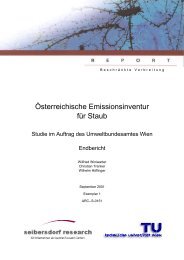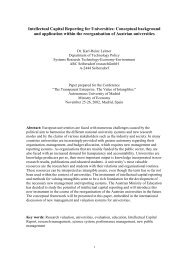ALPMON FINAL REPORT - ARC systems research
ALPMON FINAL REPORT - ARC systems research
ALPMON FINAL REPORT - ARC systems research
You also want an ePaper? Increase the reach of your titles
YUMPU automatically turns print PDFs into web optimized ePapers that Google loves.
Contract ENV4-CT96-0359 <strong>ALPMON</strong><br />
2.2.4 Radiometric Correction<br />
Remote sensing data, from space borne or airborne platforms, of land or sea surface in the visible and<br />
near infrared portion of the electromagnetic spectrum is strongly affected by the presence of the<br />
atmosphere on the Sun-target-Sensor path. The data recorded usually do not represent the exact<br />
reflectance from the target surface. This is due to radiometric effects which are partly sensor-related<br />
such as instrument calibration, and those which are scene-related such as atmospheric, topographic,<br />
illumination and view angle effects, and target reflectance characteristics. All of these effects place<br />
limitations on the proper utilisation of the sensed data for targets recognition in the specific application.<br />
In order to optimise information extraction from optically remote sensed data, radiometric correction is<br />
necessary to compensate for the effects of (i) illumination conditions at the time of image acquisition,<br />
(ii) image observation geometry, (iii) atmospheric phenomena and (iv) relief variations on the spectral<br />
signatures of the targets, on the spectral signature of the objects. To correct for these effects,<br />
normally, three prerequisites are to be met, namely (i) a radiometric calibration, (ii) an atmospheric<br />
model, and (iii) a target reflectance model.<br />
The above mentioned pre-processing requirements are applicable to remote sensing data used in all<br />
applications that involve multi-temporal or multi-sensoral imagery. These pre-processing steps are also<br />
necessary to the mere conversion of digital counts to radiance or reflectance units.<br />
From the above mentioned facts, it is clear that radiometric correction is a pre-requisite to any accurate<br />
quantitative interpretation of remote sensing data. It is one of the basic elements in the image analysis<br />
data flow. The major processing categories in it are (i) radiometric calibration, (ii) atmospheric<br />
correction and (iii) topographic correction.<br />
2.2.4.1 Topographic Normalisation (WP6)<br />
Since the project focused on applications within the alpine area, pre-processing of image data required<br />
the correction of topographic effects. Topography does not only affect the geometric properties of an<br />
image but will as well have an impact on the illumination and the reflection of the scanned area. This<br />
effect is caused by the local variations of view and illumination angles due to mountainous terrain.<br />
Therefore, identical land-cover might be represented by totally different intensity values depending on<br />
its orientation and on the position of the sun at the time of data acquisition.<br />
An ideal slope-aspect correction removes all topographically induced illumination variation so that two<br />
objects having the same reflectance properties show the same digital number despite their different<br />
orientation to the sun's position. As a visible consequence the three-dimensional relief impression of a<br />
scene gets lost and the image looks flat.<br />
In order to achieve this result several radiometric correction procedures have been developed. Besides<br />
empirical approaches, such as image ratioing, which do not take into account the physical behavior of<br />
scene elements, early correction methods were based on the Lambertian assumption, i.e. the satellite<br />
images are normalized according to the cosine of the effective illumination angle (Smith et al. 1980).<br />
However, most objects on the earth’s surface show non-Lambertian reflectance characteristics (Meyer<br />
et al., 1993). Therefore the cosine correction had to be extended by introducing parameters, which<br />
simulate the non-Lambertian behavior of the surface (Civco 1989, Colby 1990). The estimation of<br />
these parameters is generally based on a linear regression between the radiometrically distorted bands<br />
and a shaded terrain model. A comparison between four correction methods, including the nonparametric<br />
cosine correction, confirms a significant improvement in classification results, when<br />
applying the parametric models (Meyer et al. 1993).<br />
There is a general agreement within the consortium that topographic normalisation leads to an<br />
improvement of the image data in mountainous terrain. In particular the Minnaert correction produced<br />
useful results. The C-correction seems not to be the appropriate solution, but rather tends to extreme<br />
over-correction of steep slopes. However, all corrections were based on empirical analysis thus being<br />
highly depending on the actual image data.<br />
In spite of the good performance of the models some limitations are to be discussed. A prerequisite to<br />
topographic normalisation is an accurate DEM and precisely geocoded image data. According to<br />
Goodenough et al. (1990) and Itten et al. (1992) the spatial resolution of the DEM should be four times<br />
higher than the spatial resolution of the image data. Using Landsat TM images the required cell size<br />
would be less than 10m, for other image data such as SPOT or IRS-1C it would be even lower. In<br />
general no such DEMs are available for larger regions. The consequence of using lower resolution<br />
DEMs is the lack of topographic details within one grid cell which might disturb the correction locally.<br />
JR, RSDE, ALU, LMU, Seibersdorf, WSL 19




